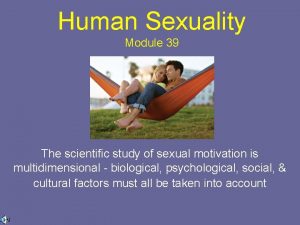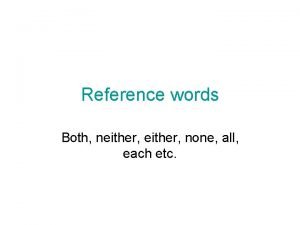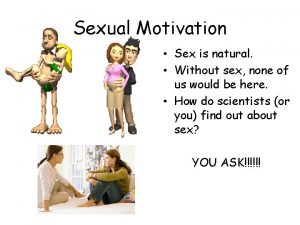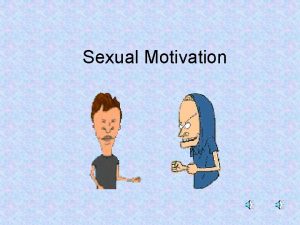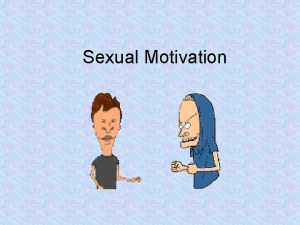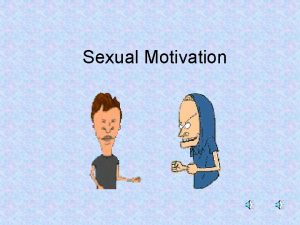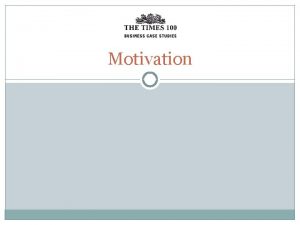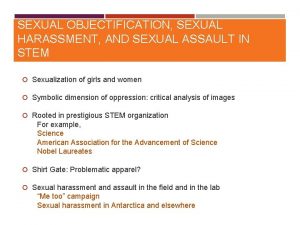Sexual Motivation Sex is natural Without sex none




















- Slides: 20

Sexual Motivation • Sex is natural. • Without sex, none of us would be here. • How do scientists (or you) find out about sex? YOU ASK!!!!!!

Kinsey’s Studies • Confidential interviews with 18, 000 people (in early 1950’s). • Surveys studied sexual behavior in males and females • Asked questions about everything imaginable… penis length, breast sizes, number of sexual partners, homosexual relationships, etc. • Scale of sexuality…. 0 to 6 where 0 is exclusively heterosexual and 6 homosexual and 7 is asexual. Click on Kinsey to see the movie trailer.

Masters and Johnson Study • During the late 50 s and early 60 s, they attached people to recording equipment and measured physical responses during sex • 382 females and 312 males were studied physiologically during sex After their research was done they ran an institute that claimed to turn gay people straight.

The Brain • Simon Le. Vay discovered that there is a cluster of cells in the hypothalamus that is larger in heterosexual men than in heterosexual women or homosexual men.

Prenatal Environment • hormonal levels in the prenatal environment have also shown to play role (more male hormones = more likely to be a straight male). • We have created homosexual male fruit flies and lesbian sheep!!!

Sexual Motivation


Sexual Motivation § Same drives, different attitudes

Sexual Motivation § Births to unwed parents

Motivation at Work § Industrial/Organizational (I/O) Psychology § the application of psychological concepts and methods to optimizing human behavior in workplaces § Flow § a completely, involved, focused state of consciousness, with diminished awareness of self and time, resulting from optimal engagement of one’s skills “The only place success comes before work is in the dictionary. ” – Vince Lombardi

Motivation at Work § Personnel Psychology § sub-field of I-O psychology that focuses on employee recruitment, selection, placement, training, appraisal, and development § Organizational Psychology § Sub-field of I-O psychology that examines organizational influences on worker satisfaction and productivity and facilitates organizational change

Motivation § Task Leadership § goal-oriented leadership that sets standards, organizes work, and focuses attention on goals § Social Leadership § group-oriented leadership that builds teamwork, mediates conflict, and offers support

Motivation at Work § Structured Interview § process that asks the same job-relevant questions of all applicants § rated on established scales § Achievement Motivation § a desire for significant accomplishment § for mastery of things, people, or ideas § for attaining a high standard

Need for Achievement • This area measures your need to achieve success in life • This is the BEST indicator of college success!!! • Typically job-oriented, but can be for other areas as well (sports, school etc. ) • Men tend to be higher in this need • People with high need in this area like moderately difficult tasks • People with low need like really easy or really hard tasks – WHY?

Achievement Motivation What motivates us to work? (School, job, sports, video games, relationships etc. . ) Intrinsic Motivators • Rewards we get internally, such as enjoyment or satisfaction. Extrinsic Motivators • Outside reward that we get for accomplishments from outside ourselves (grades or money or etc. . ) • Work great in the short run. • Can be bad because once the reward is removed the behavior may not be sustained.


Management Theory Management/Teaching styles relate closely to Intrinsic/Extrinsic Motivators. Theory X • Managers believes that employees will work only if rewarded with benefits or threatened with punishment. • Think employees are Extrinsically Motivated. • Only interested in Maslow’s lower needs. Theory Y • Managers believe that employees are internally motivated to do good work and policies should encourage this internal motive. • Interested in Maslow’s higher needs. The surprising truth about what motivates us

When Motives Conflict • Approach-approach conflict – Choice between two good things • Avoidance-avoidance conflict – Choice between two bad things • Approach-avoidance conflict – Choice that has both positive and negative characteristics

Need for Power • This area measures your need to influence and/or control other people • If high in this area, you like to be dominant and be in charge of situations • People are HIGH in this area do not deal with conflict and frustration well • MEN with high need for power tend to correlate with a variety of aggressive and compulsive behaviors

Need for Intimacy • This area measures your need to have close and warm relationships with others (FRIENDSHIPS AND ROMANCE) • People with a HIGH need for intimacy spend more time during the day thinking about relationships, smile more, laugh more, make more eye contact • WOMEN tend to have a higher need for intimacy
 Sex sex sex
Sex sex sex Snv sex
Snv sex Xxtesticles
Xxtesticles Sex sex sex
Sex sex sex Secondary sexual characters
Secondary sexual characters Gender and sexual orientation ap psychology
Gender and sexual orientation ap psychology Sexual motivation ap psychology
Sexual motivation ap psychology Module 39 sexual motivation
Module 39 sexual motivation Linkage
Linkage Sex determination and sex linkage
Sex determination and sex linkage Sex determination and sex linkage
Sex determination and sex linkage Once a sex offender always a sex offender
Once a sex offender always a sex offender The father in the poem without title
The father in the poem without title Without title diane glancy
Without title diane glancy Why does pablo neruda urge to keep quiet
Why does pablo neruda urge to keep quiet Natural hazards vs natural disasters
Natural hazards vs natural disasters Natural capital and natural income
Natural capital and natural income Leave none to tell the story
Leave none to tell the story Reference words
Reference words With malice toward none meaning
With malice toward none meaning Python none value
Python none value







